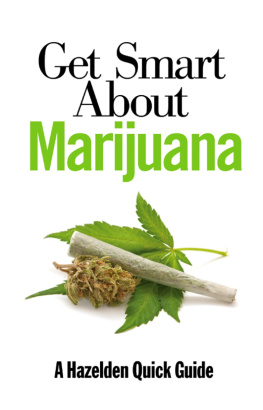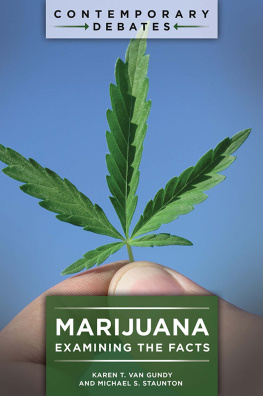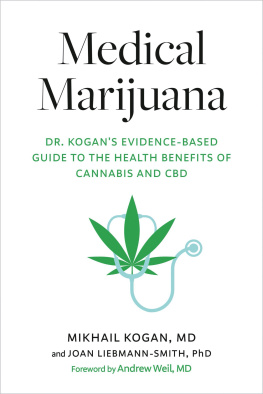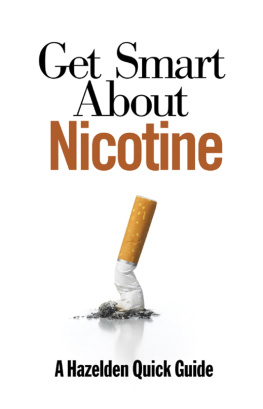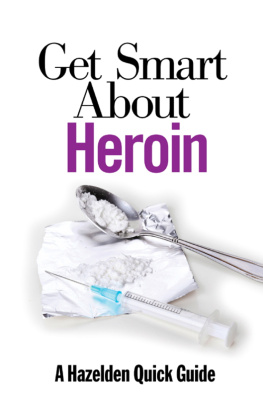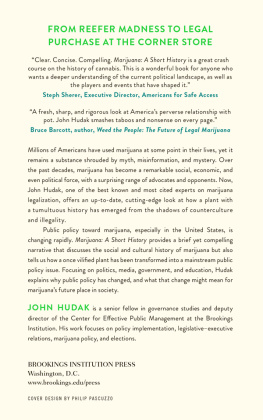Get Smart About
Marijuana
A Hazelden Quick Guide

Hazelden Publishing
Center City, Minnesota 55012
800-328-9000
hazelden.org/bookstore
2013 by Hazelden Foundation
All rights reserved. Published 2013.
No part of this electronic publication may be copied, sold, or redistributed in any form or by any means without the express written permission of the publisher. Failure to comply with these terms may expose you to legal action and damages for copyright infringement.
eISBN 978-1-61649-517-6
Editors notes:
The names, details, and circumstances may have been changed to protect the privacy of those mentioned in this publication.
This publication is not intended as a substitute for the advice of health care professionals.
Alcoholics Anonymous is a registered trademark of Alcoholics Anonymous World Services, Inc.
17 16 15 14 13 1 2 3 4 5 6
Cover design by Theresa Jaeger Gedig
Interior design and typesetting by BookMobile Design & Digital Publisher Services
Developmental editor: Peter Schletty
About Hazelden Quick Guides
Hazelden Quick Guides are short, accessible e-books that draw on the original work and best practices of leading experts to help readers address common addiction recovery and emotional health issues. The Get Smart collection describes each of the major drugs, its historical, cultural, and legal context, its addictive qualities, and information on prevention and treatment.
Introduction
After alcohol, marijuana is the most prevalent psychoactive drug used in the United States. It is an ancient crop with a rich and diverse history of uses in industry, agriculture, medicine, religion, and recreation.
In 2012, just over 36 percent of high school seniors (close to 3 out of 8) reported having tried marijuana or hash one or more times.
For comparison, half of all adults in the United States report that they are regular drinkers, and eight of ten adults have tried alcohol. About two-thirds of women and just over half of men have never tried tobacco.
So, if you are reading this and have not tried marijuana, you are in the majority, but it is very likely that you know someone who has tried the drug. And if you are a parent of a teen, know that before graduation, most likely your child will have had some exposure to marijuana, even if he or she has not tried it. (About eight of ten seniors in high school reported that marijuana was fairly or very easy to get.)
As a drug, marijuana goes by many names, including pot, grass, reefer, weed, herb, Mary Jane, and MJ. The drug is derived from the leaves, stems, seeds, and flowers of Cannabis sativa , also called the hemp plant. It has a fascinating history. In the United States, it has played more roles than the best character actor in Hollywood:
- a mainstay of agricultural production (raised by colonial farmers, including George Washington)
- a treatment for opiate withdrawal, formally listed in the U.S. Pharmacopeia
- an ingredient in patent medicines
- a reviled cause of dangerous and violent behavior, featured in the film Reefer Madness
- a symbol of counterculture among jazz musicians, beat poets, and artists, and later among the hippies of the 1960s
- a cash crop for black-market farmers and organized crime
- a coming-of-age drug or a gateway to trouble, depending on whether youre a teen or a parent
- a symbol of laziness, apathy, and disaffection popularized in movies by the stoner stereotype
- a potentially valuable medical substance fraught with political peril and partisan passion
History
Human use of the plant from which marijuana comes is ancient. Cannabis sativa is believed to have originated in central Asia, but today is found worldwide. It has been cultivated for its fiber (hemp) as well as medical and intoxication purposes for at least 5,000 years. There are a number of varieties of the plant. Some are better for fiber, and some are better for intoxication. Careful breeding of the plant has increased the level of the psychoactive chemical in the plant over the past four decades.

Hemp, marijuana, pugs, and wolfhounds
Both hemp and marijuana come from varieties of the Cannabis sativa plant. All cannabis plants contain a class of compounds known as cannabinoids. Two of these are THC (delta-9-tetrahydrocannabinol) and CBD (cannabidiol). THC produces the psychoactive effect sought after by recreational users. CBD is not psychoactive, and some believe it may actually block the effect of THC in the nervous system.
We humans are good at breeding a single species for different purposes. For example, dogs can be bred in varieties from a wee pug to a massive wolfhound. Or consider corn, which we cultivate as sweet and sumptuous varieties as well as bitter and teeth-splitting. Same species; very different genetic expressions.
Cannabis grown for hemp purposes has a THC content of less than 1 percent and may have a ratio of CBD to THC greater than one; you cant get high from it. Hemp fiber, oil, and seeds may be refined for use in a number of products, including wax, resin, rope, cloth, pulp, food, animal bedding, mulch, paint, lotions, plastics, and fuel.
Psychoactive marijuana comes from the flowering tops and leaves of the cannabis plant, which contain more of the psychoactive ingredient, THC. Cannabis plants can be bred for high THC content, and those cultivated for psychoactive purposes have a THC content of anywhere from 3 percent to 22 percent.
Hemp was widely cultivated in the United States until the middle of the last century, the last legal crops being planted in Wisconsin in the 1950s. Famously, George Washington was a hemp grower. Because the U.S. Drug Enforcement Administration has classified all marijuana as a controlled substance, hemp is not legal to grow in the United States under federal law. However, in recent years, a number of states have passed laws enabling hemp licensure. Hemp is grown legally in many countries; China is the leading producer.

The word marijuana is of uncertain origin. It may be a conflation of the Spanish proper name Maria Juana, or Mary Jane (one of the street names for marijuana). The history of the word is a study in its own right, variously traced to an indigenous Mexican word; a derivation of a Chinese word for hemp, ma ren hua , altered by Chinese immigrant workers in Mexico; a word of Arabic origin imported to Mexico from Moorish Spain; and even a derivation of the herb name marjoram.
Historical Medical Uses of Marijuana
Marijuana has been used for medical purposes since its first cultivation. Heres a brief overview, up to the early twentieth century.
- The Chinese emperor Fu Hsi referenced it as a popular medicine in 2900 BC, and the herb was included in the Chinese pharmacopeia, the Rh-Ya , in 1500 BC. By AD 100, the Chinese had more than one hundred medical uses, including treating gout, malaria, and absentmindedness. In AD 200, surgeon Hua To performed a number of surgeries using an anesthetic made from cannabis resin and wine.
- The original Hebrew version of the book of Exodus refers to a holy anointing oil that combined olive oil, fragrant herbs, and kaneh bosm , which was cannabis.
- The ancient Egyptians prescribed cannabis for glaucoma, inflammation, cooling the uterus, and administering enemas.

